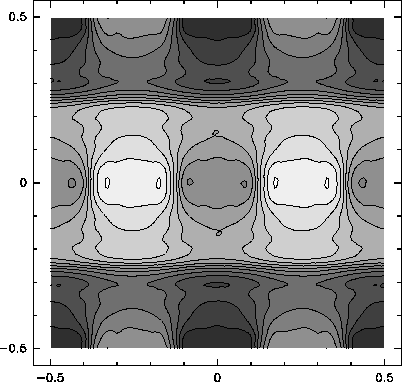The design of a more complex two-dimensional grating is much more
difficult due to the higher number of independent Fourier
coefficients. While the one-dimensional or rectangular gratings only
require the optimization of ![]() or
or ![]() coefficients, respectively, the
general two-dimensional grating uses
coefficients, respectively, the
general two-dimensional grating uses ![]() coefficients. This high number
of coefficients makes it very inefficient to randomly search for starting
values as described above.
coefficients. This high number
of coefficients makes it very inefficient to randomly search for starting
values as described above.
For this reason, we chose a slightly different approach for the optimization
of the
two-dimensional gratings. Modeling the grating as a beam combiner, we
summed the fields from the desired number of diffraction orders incident
on the grating as plane waves in the grating plane. The combined field,
( i.e. the inverse Fourier transform of the diffraction pattern),
then varies in both amplitude and phase over the grating. Since we want
to design a pure phase grating, we optimize the phases in the incident
waves to minimize the amplitude variation over the grating surface. The
Fourier series expansion of the resulting phase variation is then taken
as the starting values for the grating coefficients ![]() . The further
optimization of the grating is identical to the one-dimensional case.
. The further
optimization of the grating is identical to the one-dimensional case.
This method is very efficient in producing good starting values for the
optimization. However, since the parameter search is less complete than in
our initial method, it is less obvious that it converges to the best
possible grating. If, for instance, the optimum phase structure has a
dynamic range of more than ![]() , the random parameter search will still
model it accurately, whereas the second method introduces phase wraps.
Although these
, the random parameter search will still
model it accurately, whereas the second method introduces phase wraps.
Although these ![]() phase wraps are physically irrelevant, they
degrade the quality of the Fourier series expansion and make it more
difficult to manufacture the gratings.
phase wraps are physically irrelevant, they
degrade the quality of the Fourier series expansion and make it more
difficult to manufacture the gratings.
 |
As an example for a non-trivial two-dimensional structure,
we show in Fig. 5 a grating, which produces 8
identical beams arranged in a 2-4-2 pattern. This grating is required
for the splitting of the local oscillator in a 4![]() 4 array
receiver, which uses two interleaved 8 pixel subarrays to increase the
beam packaging density. With this 13
4 array
receiver, which uses two interleaved 8 pixel subarrays to increase the
beam packaging density. With this 13![]() 13
coefficient Fourier grating we reach a diffraction
efficiency of approximately 84%.
13
coefficient Fourier grating we reach a diffraction
efficiency of approximately 84%.